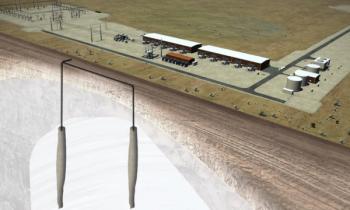
Differentiating Between Fluid Induced Instability (Oil Whirl and Oil Whip) and a Rub
Richard Thomas, P.E.
Fluid induced instabilities (oil whirl and oil whip) are characterized as occurring at a sub-synchronous vibration frequency. In many instances rubs can also occur at sub-synchronous vibration frequencies and if care is not taken in the analysis, a rub can be mis-identified as being fluid induced instability.
So let’s take a few minutes and look at these two mechanism; i.e. fluid induced instability and rubs, and discuss how to properly identify one from the other.
Fluid-induced instability (oil whirl) is a type of self excited vibration that results from the rotor’s interaction with a surrounding fluid in an enclosed space, i.e. inside a bearing or seal for example. Oil whirl can produce large sub-synchronous vibration amplitudes. The term “instability” is somewhat of a misnomer in that although initially the rotor does indeed “go unstable”, as the sub-synchronous vibration amplitude quickly grows it is bounded by the diametral clearance of the bearing and or seal and becomes “stable” at the limit cycle.
When a fluid, either liquid or gas, is contained within an annular region (gap) between two, concentric cylinders that are rotating relative to each other, the fluid is set into motion and creates a tangential force proportional to and in the direction of rotation. As the fluid is set into motion, the fluid next to the rotor will have the same velocity as the surface of the rotor, while the fluid next to the bearing will have zero velocity. There will be an average fluid velocity profile in the bearing.
For a shaft rotating inside a fluid-film bearing or seal, the fluid in the gap will have an average angular velocity slightly less than ½ rotative speed due to internal shear, frictional losses, the geometry of the bearing, the rate of end leakage out of the bearing, the eccentricity ratio of the rotor in the bearing, and the presence of any pre- or anti-swirling that may exist in the fluid.
Most bearings in large critical machines are hydrodynamic, fluid-film bearings. The rotational interaction with the surrounding fluid in the bearing always ends up swirling the fluid to some extent in the direction of rotation.
When a rotor is displaced from the center of a bearing, the converging fluid forms a pressure wedge. The pressure wedge (profile) creates a supporting force that can be separated into two components, a radial spring force that points back toward the center of the bearing and is in equilibrium with the load, and a tangential force that acts at 90° to the radial force and in the direction of rotation.
As rotor speed increases, the tangential force becomes stronger. At some speed the tangential force becomes so strong that the rotor will not return to static equilibrium. At this point, the rotor will relatively quickly spiral out into a forward precessed, very circular orbit at a sub-synchronous frequency equal to the average velocity of the fluid in the bearing. When this happens, the rotor is experiencing Oil Whirl. If the sub-synchronous frequency equals the rotor’s first critical speed, then the mechanism transitions from oil whirl to oil whip. Oil whip is a much more serious mechanism in that now the energy from the sub-synchronous fluid induced instability is being used to re-excite the 1st bending mode (critical speed) of the rotor.
For oil whirl, maximum vibration amplitudes usually occur in the bearing or seal where the instability originates. For oil whip, the maximum vibration amplitude will occur at the point of maximum deflection for the first bending mode. In the case of a traditional “beam” rotor with 90% of the rotor mass between bearings, maximum deflection is near the mid span of the rotor. Consequently, oil whip has a much higher potential for damage than oil whirl.
Fluid Induced Instability - Characteristic #1: The circumferential motion of the fluid confined within two cylinders, one which rotates, and one which is stationary, is the primary forcing function for fluid induced instability.
Fluid Induced Instability - Characteristic #2: Sub-synchronous vibration which can rapidly grow and approach an amplitude equal to the diametral clearance of the bearing or seal where the instability is occurring.
Fluid Induced Instability - Characteristic #3: Oil Whirl will occur at a sub-synchronous frequency, slightly less than 1/2X, that is equal to the average angular fluid velocity in the bearing or seal. If the sub-synchronous frequency becomes coincident with the frequency of the rotor's 1st critical speed, oil whirl will transition to oil whip.
Fluid Induced Instability - Characteristic #4: Without exception, oil whirl is forward precessed, driven in the direction of rotation by the tangential force.
Fluid Induced Instability - Characteristic #5: The shape or form of the vibration as observed in the direct, unfiltered shaft orbit data plot is circular. Fully developed oil whirl will increase to an amplitude limited by the diametral clearance in the bearing or seal.
Fluid Induced Instability - Characteristic #6: Because oil whirl occurs at a sub synchronous frequency slightly less than ½X and because it is the primary vibration component much larger than the 1X, in addition to being circular, the resulting direct or unfiltered orbit will have 2 Phase Trigger (Keyphasor®) dots on the orbit. Since the sub-synchronous frequency is slightly less than ½ X, the Phase Trigger dots will not be fixed on the orbit but will precess in a direction opposite of shaft rotation.
Since the sub synchronous vibration caused by fluid-induced instability is always forward precessed; i.e. in the direction of rotation, and very circular in shape, this fact becomes a very useful diagnostic tool to use in discriminating between the primary sub-synchronous frequency caused by oil whirl vs. the primary sub-synchronous vibration frequency caused by a rub.
RUBS
By nature of the mechanism, a rub will always involve friction and localized heating of the rotor at the point of contact. The direction of the friction force is against rotation resulting in the generation of reverse vibration component(s); i.e. vibration in the direction opposite of shaft rotation due to a force or restraint acting on the shaft in the direction opposite of rotation.
The more severe the rub, the higher the friction force, the greater the magnitude and number of reverse vibration components.
Reverse vibration components can be readily observed by one of two methods:
Ø The first method is to observe the
amount of ellipticity of the shaft orbit; i.e. the ratio of the major axis of the orbit to the minor axis of the orbit. It is the magnitude of the reverse vibration component(s) that cause the orbit to change shape from circular to some degree of ellipticity. The more elliptical the orbit, the larger the reverse vibration component(s). This is completely different from oil whirl where the mechanism is 98% forward with essentially no reverse component at all – a very circular unfiltered orbit. Significant rubs generate highly elliptical orbits due to the rub physically preventing shaft motion in the plane of the rub.
Ø
The second method is to observe the relative magnitude of both the forward and reverse vibration components at a given frequency by utilizing the full spectrum data plot. Mathematically it can easily be shown that any filtered orbit can be represented by two vectors, one which rotates in the direction of rotation (forward) and one which rotates opposite of rotation (reverse). The ratio of the magnitude of the forward vector to the magnituce of the reverse vector indicates the ellipticity of the filtered orbit at that frequency.
The full spectrum data plot contains the same amplitude and frequency information that is in the unfiltered orbit. For example, a full spectrum data plot with forward 0.46X, and essentially no reverse components would be indicative of oil whirl; i.e. all of the vibration is forward at the sub-synchronous frequency. Conversely, a full spectrum with both forward and reverse 0.46X components, with the reverse component being 50% the magnitude of the forward component, precludes this example being oil whirl because the vibration is no longer forward and circular. The vibration response has become highly elliptical as opposed to forward and circular.
In much the same way that a traditional spectrum plot breaks down a complex vibration waveform into its individual filtered frequency components that can be summed back to reproduce the original complex waveform, the full spectrum data plot breaks down a complex orbit shape into its individual filtered frequency orbits that can be summed back to reproduce the original complex orbit shape.
“Complicated orbits will have forward and reverse [vibration] components at many frequencies. Each pair of components represents a set of vectors that rotate in forward and reverse directions at a specific frequency. The most complex orbit can always be described by a set of such vectors and full spectrum lines. The lines in the full spectrum represent the precessional structure of the orbit…..The entire orbit can be expressed as the sum of its forward and reverse components in the same way that a timebase waveform can be expressed as the sum of its sine wave components.
At first glance, the full spectrum might seem abstract. What is significant about forward and reverse precession? It lets us easily identify key orbit characteristics that might otherwise be obscured. Precession direction and ellipticity provide insight into the state of health of a machine. More importantly, some rotor system malfunctions can have characteristic signatures on a full spectrum plot that are not available on traditional spectrum plots. These characteristics can be used to discriminate between different malfunctions that produce vibration with similar frequencies.”
When a rub does occur, it becomes an additional point of support for the rotor system which has the effect of stiffening the rotor due to additional support between the bearings. One of the effects of this stiffening is to modify the frequency(ies) of a critical speed(s). A second effect of a rub is that the resulting force due to friction will transfer heat to the rotor.
However, the predominant effect of a rub, like an impact, is to generate white noise energy at all frequencies. As with the case of structural modal testing with an impact hammer, this white noise energy will excite the resonances that are present with the lowest mode being the easiest to excite. For the typical rotor / bearing system, the lowest mode (the 1st critical speed) is the frequency that is the easiest to excite. It is important to remember that in the presence of a rub, usually it is the 1st critical speed that will be modified to a slightly higher frequency and it is this modified resonance frequency that will be excited by the rub and show up in the spectra data as a sub-synchronous frequency.
Rub Characteristic #1: Due to friction and localized heating the rotor will experience localized deformation with the potential to bow the rotor. If the rotor bows, this will be observed by a change in the 1X (running speed) vibration response due to a change in the effective balance state of the rotor. Whether or not a change in the 1X vibration response will be observed is dependent on:
the rub location
how severe the rub is
whether or not the rub is dry or lubricated
how much heat is actually transferred into the rotor
Some rubs will have little or no effect on the 1X response, while other rubs will primarily drive a change in the 1X vibration response. It is totally dependent on the type of rub, the location of the rub, and the amount of heat actually transferred to the rotor.
Rub Characteristic #2: Due to friction a rub will always introduce reverse vibration components.
Rub Characteristic #3: The more severe the rub, the greater the potential for observing both multiple forward and reverse vibration components in the full spectrum, including the potential for both sub and super harmonic content. At any given frequency the ratio of the amplitude of the forward vibration component to the reverse vibration component will determine the ellipticity of the filtered orbit at that frequency.
Rub Characteristic #4
Truncation of either the time base waveform or the unfiltered orbit is a clear indication of a uni-directional force or restraint; i.e. a point of contact or rub. It is this truncation of the time base waveform that when processed through a FFT will generate higher order harmonic content in the spectra data.
Fundamentals of Rotating Machinery Diagnostics; Bently, Donald. E.; Chapter 8, pages 120-122
Newsletter
Power your knowledge with the latest in turbine technology, engineering advances, and energy solutions—subscribe to Turbomachinery International today.




